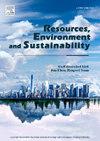促进土壤管理方式:生物电化学技术
IF 12.4
Q1 ENVIRONMENTAL SCIENCES
引用次数: 0
摘要
微生物自身产生或消耗的电子传递是物质转化和能量传递的基本氧化还原力。土壤中微生物的数量和种类最为丰富,微生物电子传递与土壤演化过程以及主要元素循环耦合的生态功能日益受到重视。开发土壤生物电化学系统是实现土壤环境可持续管理的一种便捷、有效的途径。在这篇综述中,研究了元素转化的影响,包括碳、氮、铁和硫,主要关注土壤BES在监测生物电流传导方面的效率。并从物理、化学和生物过程三个方面综述了影响土壤BES的因素。综述了土壤生物电流传导在去除污染物、改善碱性酸化、淡化海水、脱毒重金属、减少甲烷排放和提高土壤肥力等方面的生态功能。最后,提出了土壤BES在电活性微生物鉴定、电子传递途径、元素循环调控和关键应用等方面的知识缺口和前景。总体而言,土壤BES将为改善环境控制方法和农业可持续性提供多方面的支持。本文章由计算机程序翻译,如有差异,请以英文原文为准。

Promoting soil management ways: Bioelectrochemical technology
Electron transport derived from microbial self-generation or consumption is a fundamental oxidation–reduction force for matter transformation and energy communication. The most abundant quantity and species of microorganisms are present in soil, and the ecological functions of microbial electron transfer coupled with soil evolution processes as well as the main element cycles have received increasing attention. Developing soil bioelectrochemical system (BES) is a convenient and efficient approach for the sustainable management of soil environment. In this review, the effects of element transformations, including carbon, nitrogen, iron, and sulfur, were examined, with a primary focus on the efficiency of a soil BES in monitoring biocurrent conduction. Moreover, the factors affecting the soil BES were summarized from the perspective of physical, chemical and biological processes. The ecological functions of soil biocurrent conduction for removing pollutants, amending alkaline acidification, desalination, detoxifying heavy metals, reducing methane emissions, and increasing soil fertility were subsequently reviewed. Finally, knowledge gaps and perspectives involving the identification of electroactive microorganisms, electron transport pathways, the regulation of element cycles, and key applications of soil BES were proposed. Overall, soil BES would provide versatile support to improve the environmental control approach and agricultural sustainability.
求助全文
通过发布文献求助,成功后即可免费获取论文全文。
去求助
来源期刊

Resources Environment and Sustainability
Environmental Science-Environmental Science (miscellaneous)
CiteScore
15.10
自引率
0.00%
发文量
41
审稿时长
33 days
 求助内容:
求助内容: 应助结果提醒方式:
应助结果提醒方式:


